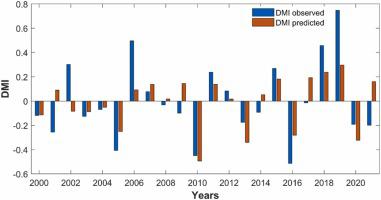Dynamics of Atmospheres and Oceans ( IF 1.7 ) Pub Date : 2023-12-28 , DOI: 10.1016/j.dynatmoce.2023.101432 Prasanth A Pillai , V. G Kiran , K. V Suneeth

|
Indian Ocean Dipole (IOD) is the major interannual ocean-atmosphere interaction phenomena in the Indian Ocean (IO) and is influenced by external forcing such as El Nino Southern Oscillation (ENSO). Meanwhile, its co-occurrence and stronger relationship with ENSO have decreased during recent decades. The IOD variability also reduced after 2000, accompanied by a shift of the western pole to central IO extending further southward. The study reports that the boreal fall (SON, September, October, November) season IOD has an intensified relationship with the previous winter Subtropical Indian Ocean dipole (SIOD) and spring season equatorial north tropical Atlantic (NTA) SST anomalies., while the ENSO relationship is reduced from its pre-2000 value. It is found that the persistent warming (cooling) in the western side of positive (negative) SIOD during the previous winter induces easterly (westerly) wind anomalies in the equatorial IO during the following summer and fall, leading to positive (negative) IOD events. These IOD events have the western pole shifted to south-central IO instead of the canonical northwestern warming. The spring season NTA SST anomalies induce stronger summer season circulation and SST gradient in the equatorial Pacific, like ENSO. During the SON season, this pattern is associated with cooling and easterly wind anomalies in the tropical eastern IO and IOD. These two patterns explain the major mode of IOD variability after 2000. While the IOD associated with NTA have co-occurring ENSO during summer and fall, the SIOD-induced IOD events are independent of ENSO in the Pacific. Thus, these two predictors provide long-lead predictability (2–3 seasons ahead) of IOD for both ENSO co-occurring and non-ENSO IOD events. However, the IOD predictability of seasonal prediction models mainly depends on the ENSO-IOD relationship, resulting in reduced IOD skills for many of them after 2000. The models such as COLA-CCSM4, which has improved skill have stronger than observed ENSO-IOD relationship than the pre-2000 period. A linear regression model including SIOD and NTA SST indices of the previous winter and spring season respectively as predictors simulates IOD with a skill of around 0.65 during the recent period, indicating the necessity of seasonal prediction models to capture the variability in the southern IO and NTA and their teleconnections for better prediction of IOD in the recent period of reduced ENSO skill.
中文翻译:

近几十年 ENSO-IOD 关系减弱期间,印度洋偶极子 (IOD) 新预测因子的作用得到加强
印度洋偶极子(IOD)是印度洋(IO)主要的年际海气相互作用现象,受到厄尔尼诺南方涛动(ENSO)等外强迫的影响。与此同时,近几十年来,它的共现性和与 ENSO 的更强关系有所减少。2000年以后IOD的变化也减少了,伴随着西极向IO中心的转移并进一步向南延伸。研究报告指出,北半球秋季( SON、9月、10月、11月)季节IOD与前期冬季副热带印度洋偶极子(SIOD)和春季赤道北热带大西洋(NTA)海温异常关系密切,而ENSO关系较 2000 年之前有所下降。研究发现,前一冬季正(负)SIOD西侧持续增温(变冷),诱发来年夏秋季赤道IO出现东(西)风异常,导致正(负)IOD事件。这些 IOD 事件使西极转移到 IO 中南部,而不是典型的西北变暖。与 ENSO 一样,春季 NTA 海温异常会导致赤道太平洋夏季环流和海温梯度增强。在 SON 季节,这种模式与热带东部 IO 和 IOD 的降温和东风异常有关。这两种模式解释了2000年后IOD变化的主要模式。虽然与NTA相关的IOD在夏季和秋季与ENSO同时发生,但SIOD引起的IOD事件与太平洋的ENSO无关。因此,这两个预测因子为 ENSO 同时发生和非 ENSO IOD 事件提供了 IOD 的长期可预测性(提前 2-3 个季节)。然而,季节性预测模型的IOD可预测性主要取决于ENSO-IOD关系,导致2000年以后许多模型的IOD技能下降。诸如COLA-CCSM4等具有改进技能的模型比观测到的ENSO-IOD关系更强与 2000 年之前相比。分别包含前一冬季和春季的 SIOD 和 NTA 海温指数作为预测变量的线性回归模型模拟近期 IOD 的技能在 0.65 左右,这表明季节预测模型有必要捕捉南部 IO 和 NTA 的变化及其遥相关,以便在最近 ENSO 技能下降的时期更好地预测 IOD。



























 京公网安备 11010802027423号
京公网安备 11010802027423号